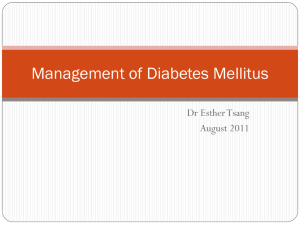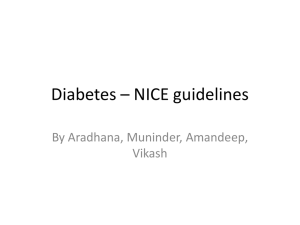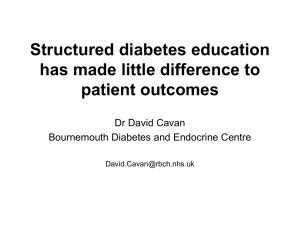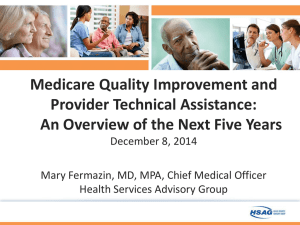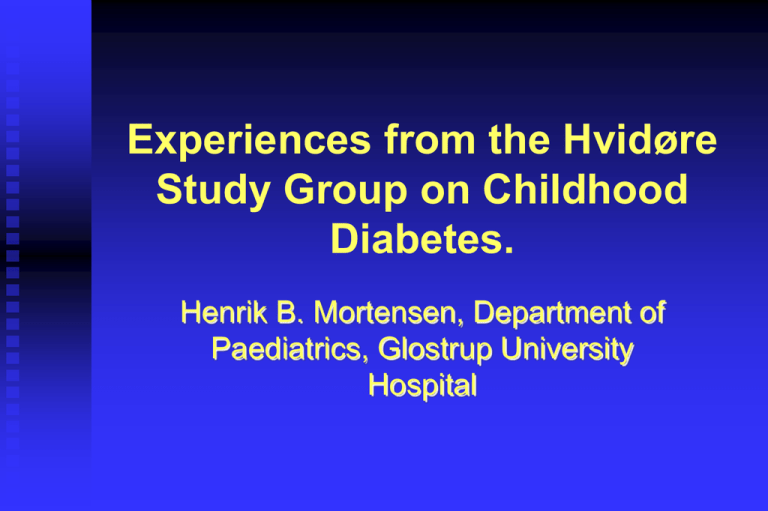
Experiences from the Hvidøre
Study Group on Childhood
Diabetes.
Henrik B. Mortensen, Department of
Paediatrics, Glostrup University
Hospital
The Hvidøre Study Group on
Childhood Diabetes
The purpose of the group to improve the
management of children and adolescents
with type 1 diabetes on a worldwide scale by:
Stimulating research
Improve the quality of care
Disseminate knowledge of childhood
diabetes
The Hvidøre Study Group on
Childhood Diabetes
n
n
The task for the group is to establish a
research network to carry out multicenter
investigations to share and compare data on
childhood diabetes.
The Study Group consist of medical doctors
all specialized in paediatrics from 22 centres
from 18 countries in Europe, North America
and Japan
Members of the Hvidøre Study
Group on Childhood Diabetes
H.B. Mortensen, Denmark
H.-J. Aanstoot, Netherlands
J. Aman, Sweden
J.A. Atchison, USA
F. Chiarelli, Italy
D. Daneman, Canada
T. Danne, Germany
H. Dorchy, Belgium
B. Dinesen, Denmark
P. Garandeau, France
R.W. Holl, Germany
P. Hougaard, Denmark
S. Greene, U.K.
H.M.C.V. Hoey, Ireland
E.A. Kaprio, Finland
M. Kocova, Macedonia
P. Martul, Spain
N. Matsuura, Japan
O. Søvik, Norway
K.J. Robertson, U.K
E.J. Schoenle, Switzerland
P.G.F. Swift, U.K
R.M. Tsou, Portugal
M. Vanelli, Italy
Publications
Comparison of metabolic control in a cross-sectional
study of 2.873 children and adolescents with IDDM from
18 countries. Diabetes Care 1997;20:714-720.
Insulin management and metabolic control of Type 1
diabetes in childhood and adolescence in 18 countries.
Diabetic Medicine 1998; 15:752-759.
Persistent center differences over 3 years in glycemic
control and hypoglycemia in a study of 3,805 children
and adolescents with type 1 diabetes. Accepted for
publication: Diabetes Care
Good Metabolic Control is Associated with Better
Quality of Life in 2,101 Adolescents with Type 1
Diabetes. Submitted
The Hvidøre Study Group on
Childhood Diabetes
Metabolic control and insulin management in the
real world
The relation between HbA1c and insulin regimens
over a three year period
Metabolic control and quality of life
Study design
Multicenter cross-sectional investigation with 22
participating paediatric departments from 18 countries
in Europe, Japan and North America.
The HbA1c concentration was determined once and
analyzed both locally and centrally at The Steno
Diabetes Center, Denmark.
Age, sex, duration of diabetes, height, body weight,
insulin regimen and number of severe hypoglycaemic
events were recorded.
HbA1c analysis
Samples were collected locally using the Biorad- HbA1c
Sample Preparation Kit and mailed to the central
Laboratory
Automatic high pressure liquid chromatography
(Bio- Rad- VariantTM)
Normal range is 4.4 – 6.3 (mean 5.4)%
The interassay SD is 0.15%
HbA1c results were found to be 0.3% higher than the
DCCT level by direct sample exchange
11
10
HbA1C (%)
Female
2 inj.
3 inj.
4+ inj.
9
8
7
6
1.3
1.2
1.1
1.0
0.9
0.8
0.7
0.6
0.5
0.4
0.3
***
*
*
0
5
10
Age (years)
15
BMI (kg/m2)
Insulin dose (U/kg/24h)
0
20
25
24
23
22
21
20
19
18
17
16
15
5
10
15
20
**
**
*
0
5
10
Age (years)
15
20
Percentage of children
using any pre-mixed insulin
50
HbA1C (percent)
11
40
10
30
9
20
8
10
* * *
7
Males
Females
0
Short + interm Two injections per day
Premixed
6
0
5
10
Age (years)
15
20
0
5
10
Age (Years)
15
20
Summary
In 3000 children and adolescents only one third had HbA1c
values < 8%
HbA1c increased during maturation of both genders
irrespective of insulin regimen
HbA1c differed significantly across 22 centres irrespective of
insulin regimen
Adolescent females on 4 or more insulin injections had
significantly higher insulin dose and BMI.
The rate of severe hypoglycaemia was related to younger
age and lower HbA1c level.
The Hvidøre Study Group on
Childhood Diabetes
Metabolic control and insulin management in
the real world
The relation between HbA1c and insulin
regimens over a three year period
Metabolic control and quality of life
Objectives
To investigate if
blood glucose control changes
from 1995 to 1998 in an international cohort of
children with type 1 diabetes aged 11-18 years in
1998
To analyse differences in blood glucose control
among centres in the 3 year period and relate
possible changes to insulin regimen and daily
insulin dosage
To assess centre differences in incidence of
severe hypoglycaemic events
Flow diagram for patients participating in
the international cohort investigation
1,767 patients age 8-15 years in ‘95
229
55
55
178
223
105
30
1
DM duration < 1 year in 1995
Insufficient data
Transferred to other Paed.Clinic
Transferred to Adult Clinic
Other (narrow window)
Unknown
Declined
Dead
This study group consisted of
891 patients
Distribution of HbA1c
40
Year
1995
1998
HbA1c in 1995
(grand mean): 8.7% (1.6%)
35
% of patients
30
HbA1c in 1998
(grand mean): 8.9% (1.6%)
25
20
15
10
5
0
<5
5-6
6-7
7-8
8-9
9-10
HbA1c (%)
10-11
11-12
12-13
> 13
Injection frequency
70
60
Number of injections
2
% of patients
50
3+
40
30
HbA1c in 1995
(grand mean): 8.7% (1.6%)
20
HbA1c in 1998
(grand mean): 8.9% (1.6%)
10
0
1995
1998
Year
HbA1c by centre for ‘95 and ‘98
HbA1c
percent
12
The 1995 baseline level, and the three year
change for HbA 1c
for the 21 centres.
11
10
9
*
* *
* *
8
7
6
Centers sorted by HbA 1c in 1995
*
Centre changes in HbA1c adjusted for sex, age,
duration of type 1 diabetes
Number of
injections
HbA1c %
+
o
-
2
0
0
Insulin dose
-
+
3
1
0
o
7
8
0
+
1
3
0
HbA1c %
+
o
o
6
9
0
1
1
0
+) significant increase, o) no significant change, -) significant decrease
Rate of severe hypoglycaemic events
according to the Poisson model
Incidence per 100 patients years
Age (13 yr), duration (5 years)
20
Centres significantly:
15
above
below
Centres not significantly:
10
different
HbA1c (grand mean):
8.9% (1.6%)
5
0
5
6
7
8
9
10
11
Individual HbA1c (per cent)
12
13
14
15
Summary
No significant change in HbA1c for the 3 year
period despite the use of three or more daily
insulin injection increased from 42 to 70%.
HbA1c varied significantly among centres.
Only 2 centres improved their metabolic control
significantly in the 3 year period.
Fewer severe hypoglycaemic events in
centres with a HbA1c significantly below
the grand mean.
Metabolic Control and
Quality of Life
The DCCT study and the recent ISPAD
guidelines recommend a treatment target for
HbA1c of 7.5% in children and adolescents.
Will strict metabolic control influence the
quality of life in adolescents with diabetes?
COMPARISON WITH OTHER QOL STUDIES
Author
Fonagy P,
Arch Dis Child, 1987
n
age (yrs)
Correlation with QOL
Poor control = better QOL
Ingersoll and Marrero,
Diabetes Educ, 1991
74
10.8-20.8
Guttman-Bauman,
Diabetes Care, 1998
69
10-20
Good control=better QOL
Grey,
Diabetes Care, 1998
52
12-20
None
None except health perception
Metabolic Control and
Quality of Life
The study involved 20 centres in 17 countries in
Europe, Japan and North America.
Adolescents aged 10-18 yrs at each study centre
were invited to participate.
2,101 adolescents were enrolled.
Samples and information from 79% of all patients
registered at the centres were obtained.
Demographic data and metabolic control on
2,101 adolescents with type 1 diabetes
Age (yr)
Diabetes duration (yr)
BMI (kg/m2)
HbA1C (%)
Incidence of severe
hypoglycemia (events
per 100 patient-years)
Boys
(n=1085)
Girls
(n=1016)
P-value
13.8 ± 2.1
13.8 ± 2.1
0.86*
5.1 ± 3.8
5.4 ± 3.8
0.06+
20.8 ± 3.2
21.8 ± 3.6
8.6 ± 1.6
8.9 ± 1.7
15.5
Results as means ± SD
*Adjusted for Center, + Adjusted for center and age,
# Adjusted for center, age and duration of diabetes.
15.7
<0.0001#
<0.01#
0.90#
Patient characteristics on insulin management.
Daily insulin regimen
Boys
(n=1085)
Girls
(n=1016)
1 injection
8
10
2 injections
472
380
3 injections
295
287
4 or more injections
307
339
Premixed insulin, n (%)
445 (41)
407 (40)
0.66
Insulin dose (U/kg/day)
0.94 ± 0.32
1.01 ± 0.32
<0.0001#
Results as means ± SD
# Adjusted for center, age and duration of diabetes.
P-value
<0.05
Quality of Life Questionnaires
Adolescent
- DQOL questionnaire
- (Ingersoll and Marrero, 1991)
Parent
constructed
- Family Burden questionnaire
Health - Family Burden questionnaire
Professional
constructed
Questionnaire for Adolescent DQOL
23 questions on impact of diabetes
11 questions on worries
17 questions on satisfaction
1 question on health perception
Questionnaire for Parents and for
Health Professionals
Burden relating to diabetes
a) Medical treatment/nursing tasks
b) Disruption in family routines
c) Physical or psychological problems in the child
d) Restriction in child's social and school activities
e) Long term health concerns.
We assessed family burden as one aspect of QOL
in the family setting, which is of particular
concern to health professionals.
Translation and cross-cultural adaptation of
the questionnaire to each of the 14
languages:
Forward translation from English to the
national language of the country
Backward translation from the national
language to English
Local lay panel testing
The consultant and the Originator discussed
the report and prepared the final validation
Completion of the questionnaires
Patients and parents completed questionnaires
confidentially
Staff completed questionnaires independently.
All forms were forwarded to the coordinating center.
All questionnaires were received within 2-3 weeks
of blood collection for glycated haemoglobin.
A middle score of 3 was used for missing questions
when at least 70% questions on the relevant
subscale was answered.If <70% answered forms
discarded.
Internal validity and consistency of the
multiple item instrument
Questionnaire completion rates for adolescents,
parents and health professionals (93 percent, 89
percent and 94 percent, respectively)
Item completion rates for all three groups (98.6–
99.8 percent).
Cronbach’s a coefficient values for the
questionnaires were:
Adolescent DQOL- impact 0.79, worries 0.84,
satisfaction 0.92;
Parents 0.80 and health professionals 0.86,
Quality of life scores with age perceived by
adolescents, parent and health
professionals
Age, gender, high and low HbA1c selected as
10th (6.8%) and 90th percentiles (10.8%)
Illustrate the variation in QOL score due to
metabolic control.
All QOL scores were linearly transformed:
Best possible score 0
Worst possible score 100
Impact of diabetes in adolescents by age,
gender and HbA1C
Score
30
HbA1 C
Impact of diabetes
28
F
10.9%
M
10.9%
F
6.8%
M
6.8%
26
24
22
Years
11
12
13
14
15
Age
16
17
18
Worries about diabetes in adolescents by
age, gender and HbA1C
Score
30
Worries about diabetes
HbA1 C
25
F
10.9%
F
6.8%
M
10.9%
M
6.8%
20
15
Years
11
12
13
14
15
Age
16
17
18
Satisfaction with life in adolescents by age,
gender and HbA1C
HbA1 C
Score
Satisfaction with life
35
M
10.9%
F
10.9%
M
6.8%
30
F
25
6.8%
20
Years
11
12
13
15
14
Age
16
17
18
Health perception in adolescents by age,
gender and HbA1C
Score
40
HbA1 C
Health perception
35
M
10.9%
F
10.9%
M
6.8%
F
6.8%
30
25
20
15
Years
11
12
13
14
15
Age
16
17
18
Metabolic Control and Quality of Life
Key messages
First large international multi-language study
evaluating the relationship between metabolic control and
QOL in 2,101 adolescents with diabetes.
Lower HbA1c is associated with better QOL of
adolescents and lesser perceived family burden by
parents and health professionals.
No relation between QOL and the actual insulin
regimen.
Speculation
Young people with excellent QOL:
Good physical and psychological balance
Facilitate better metabolic control through
improved self-care
Bad metabolic control = poor QOL
Conclusion
Our studies showed
No relationship between blood glucose control,
insulin dose and number of dailly injections
Good metabolic control can be achieved without
increasing the risk of severe hypoglycaemic events
A clear relationship between metabolic control and
quality of life


